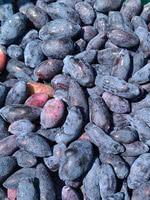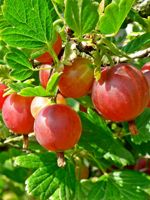Mon-Fri 9am - 5pm Mountain time
Blue Stuart Haskap (Honeyberry) vs Sebastien Gooseberry
Lonicera caerulea Blue Stuart
Ribes uva-crispa Sebastien
NOT AVAILABLE THIS SEASON - MIGHT RETURN
NOT AVAILABLE THIS SEASON - MIGHT RETURN
(new stock expected: fall of 2026)
The Blue Stuart Haskap is a fruit-bearing shrub that produces medium-sized, oval-shaped and sweet berries. Their taste is typically described as something between a raspberry and a blueberry. The berries are ready for harvest through June and July, and are of medium firmness.
The Blue Stuart Haskap, or Blue Stuart Honeyberry is a cultivar of Russian origin bred by Lidia Stuart who grew up in far eastern Russia.
Blue Stuart is a late pollinating variety. Pair with other late pollinators to have a higher yield.
Blue Banana is a great companion variety.
Sebastien Gooseberry is a nearly thornless variety that produces medium-sized, red gooseberries. When the berries are fully ripe they are quite sweet and great for fresh eating. They can be stored for up to two weeks in the fridge. For baking and preserves, they are often picked when under-ripe when they are firm and tart. The general harvest period is anywhere from July to September.
Sebastien Gooseberry is a Canadian variety that was developed at the Agriculture and Agri-Food Canada research station in Ottawa.
Gooseberries are self-pollinating but planting with another variety will increase yields.
Blue Stuart Haskap (Honeyberry) Quick Facts
Sebastien Gooseberry Quick Facts
Toxicity: leaves are toxic to humans

